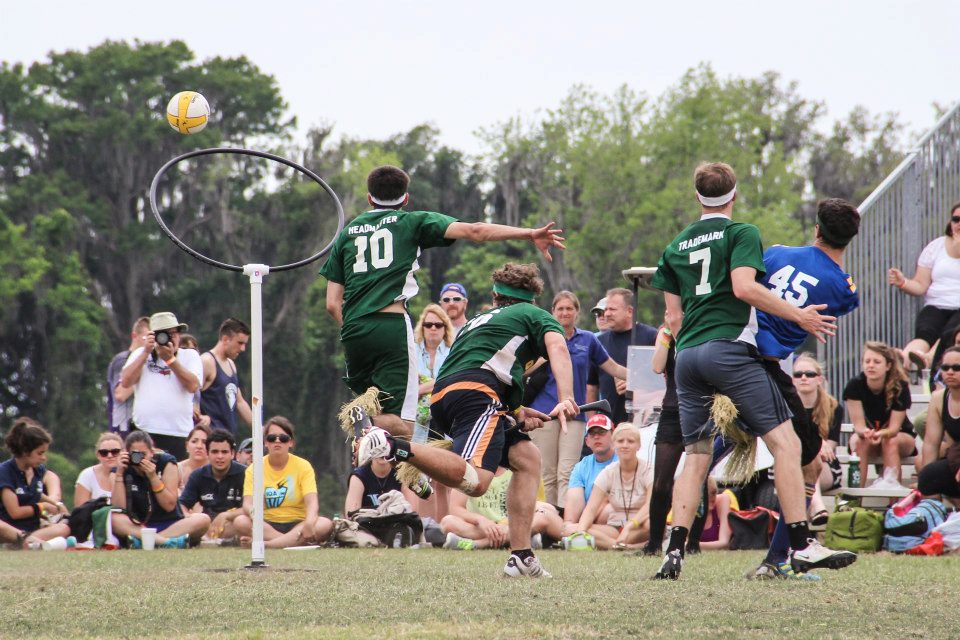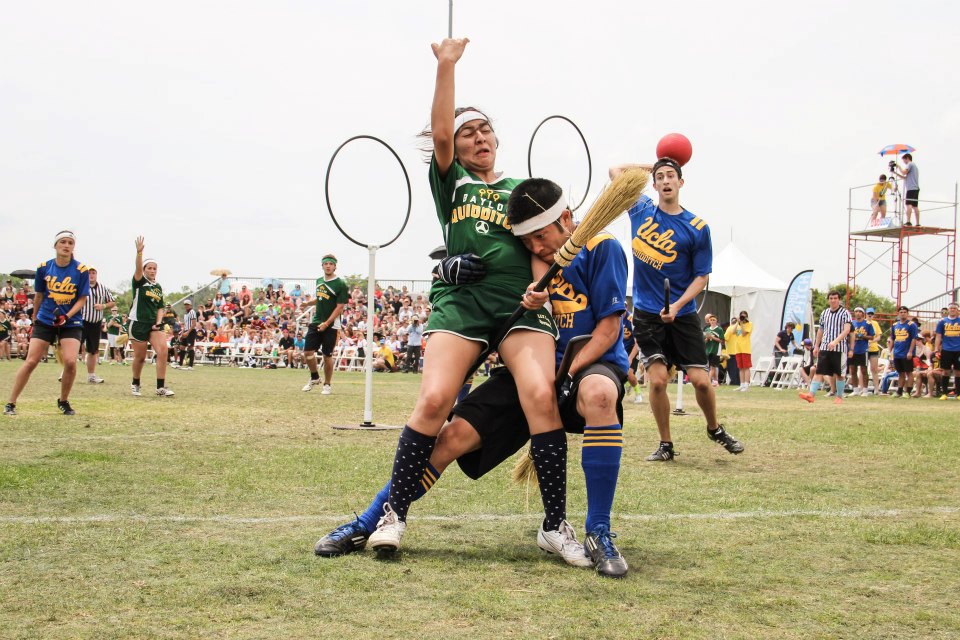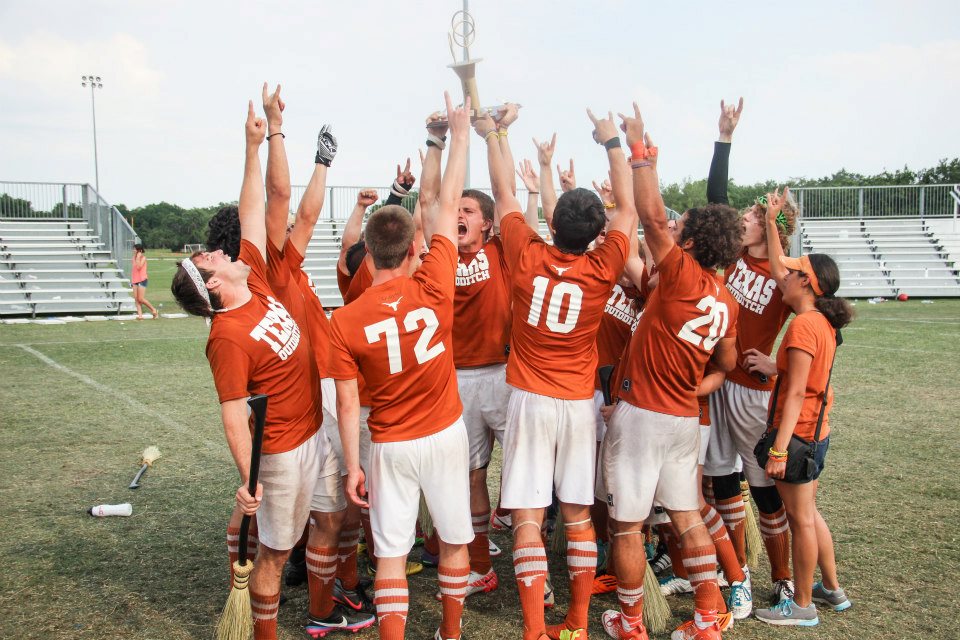Antwerp QC, Much of Belgian Core, Leaves Competitive Quidditch
How do you become the best? With a new champion for the first time in our sport’s young history, it has to the question on the minds of so many teams as the summer comes around and a new season begins. What tools did the final four teams have in their arsenal that led them to success?
The world champion until this year had always been Middlebury, a team that rarely competed outside their school grounds and traditionally has not supported the growth of the competitive side of the game. Especially towards the end of their run, many of their successes in bracket play were often attributed to a lucky break or a lucky snitch grab as opposed to the actual team’s ability. Luckily, thanks to standardization of the sport and a more regular schedule of play, quidditch is moving quickly in the right direction in terms of the best team winning.
For anyone that watched the Div. I semifinals and finals at World Cup VI, it’s hard not to agree that the teams competing at that stage were the best four in the tournament. Other teams could be in the conversation, but, when it comes down to it, University of Texas, UCLA, Baylor, and Bowling Green all succeeded in those game-defining moments, catapulting all of them through the tournament into the late games on Sunday afternoon. Watching those games fully affirmed to me that there is a finally a central formula to quidditch success.
Typically, when referring to how good a team is in quidditch, most people currently focus on two areas: experience and athleticism. We are finally entering a time where there is more complexity in the analysis of good teams, because to be successful, simply being more experienced or more athletic is not going to cut it anymore. This is especially true because the pool of teams with experience, athleticism, or both is now widening, and those elements on their own will not serve to set one team apart. Yes, generally more experienced and athletic teams are going to go further in a tournament, but they will have difficulty making into later bracket play without the addition of other crucial elements.
The final four teams each illustrate some of those additional elements that are now key to success in today’s game. Without them, competing at the highest level is a pipe dream at best. And while all four of these teams incorporated each of these elements into their play, each was defined most by a single one, which we’ll look at below.

Dan Daugherty’s athletic talent shined at the World Cup, but his leadership may have shined even brighter. Credit: Leslie Bartsch
Bowling Green State University – Leadership
Every team has some hierarchy of leadership, from captains to coaches to presidents, or a combination of all three. The difficulty here is that there are very few people that can actually serve as successful leaders. Daniel Daugherty is by far one of the best leaders I have seen, period. He was rightfully awarded the title of Quidditch’s Man of the Year for 2012, and after BGSU’s success at World Cup VI, I believe it will be difficult for anyone to dethrone him for 2013.
Sometimes it is difficult for a game-changer or key player to be a successful leader. They can become too inwardly focused, often feeling like the result of the game rests too heavily on their shoulders, which causes them to lose sight of promoting the growth of their team. Yes, many game-changers are in charge of their respective teams; however, in my experience many of them are not the best leaders. They fall into leadership roles because many people associate leadership with skill, but an ability to score points does not mean someone is a good fit to lead.
Daugherty strikes a perfect balance of being a game-changing player while still motivating and getting the most out of the rest of his squad. He made many monumental plays that helped BGSU on their trip through the tournament, but the team was what succeeded and made it all the way to the semifinals, not just Daniel. He truly believed in his team, which allowed them to make just as many game-altering plays as he did. A lot of people I’m sure believe – incorrectly – that Daniel carried BGSU. He didn’t carry them. In actuality, he supported them. As I stated above, he was “a” game-changing player, not “the” game-changing player, which signifies the team had many game-changing players – the ultimate goal of any true leader. Motivating and inspiring a team leads to individual player growth, which leads to team growth, which leads to team success, as BGSU and Daniel Daugherty illustrate beautifully for us.

As UCLA’s Zach Luce learned here, the Baylor defense was one of the toughest puzzles to solve at World Cup. Credit: Lauren Carter
Baylor University – Focus
Entering this season, not many people expected Baylor to make as big of a splash as they did. As soon as they upset University of Texas in the semifinals of Diamond Cup in the fall, the biggest question on everyone’s mind was: how did the Baylor Bears do it? They had never competed in a World Cup before, and had only been in existence for a year. Their exponential improvement, which ended in a trip to the Final Four of their very first cup, a feat pulled off by just one other team in the past three cups, was a combination of many things, but above all, it was a testament to their focus.
Baylor is a team that developed around its players’ own strengths and weaknesses and rather than copy the strategies of other teams. They developed a very organized focus on how to get better as a team, and didn’t deviate from their plan after a disappointing loss. Adapting to opponents’ strategies is one thing, but changing your entire play style and game plan is another. When you start changing too many fundamental aspects of what you do, you start to lose your focus on your team’s strengths and how to utilize them. Players can start to lose confidence through too many changes, and in the end a better team can always lose a match in which they allow the other team to take them off their game.
The Bears have shown tremendous patience in many tough games where they trust their game strategy and remain collected. They don’t break down at the first sign of trouble, and they are okay with allowing a few goals in order to stay on their game, because doing so has brought them a lot of success this season. From tournament to tournament, it was very obvious that they worked very hard to improve upon what they already knew as their main priority, and they incorporated new strategies or made changes as a second priority. Innovation and change are both good, especially in a sport that is still in its infancy, but many times this results in teams or players essentially trying to run before learning how to walk. Baylor demonstrated that a strong drive to remain focused on a high level team strategy will bring about a lot of success.

It wasn’t Asher King Abramson’s arm that carried UCLA, but the way he worked seamlessly with his team. Credit: Lauren Carter
UCLA – Teamwork
Teamwork is a much more complex element than people understand because it is assumed that a team must inherently employ teamwork. This belief, oddly enough, is not always so tautologically true, as many people might recognize when they really analyze whether a team is a full functioning unit or just a group of skilled individuals. The difference is that a true team will have a singular purpose everyone understands and works towards together, and a group of individuals will all have their own purposes and not be as concerned with what their teammates are doing.
UCLA displayed an immense amount of teamwork in their playing at World Cup, as did many teams this year, as people have begun to realize that a handful of players can’t carry a team that far anymore. However, UCLA was truly unique in their ability to incorporate their beating and chasing games together so smoothly. Many teams allow much of the beating and chasing game to remain separate in terms of strategy, and sometimes it’s like there are two games going on at once. The Bruins did an amazing job of incorporating their beaters and chasers into every aspect of the game, and adapting as a team to any challenges they faced. It was extremely evident that every player supported and trusted his or her teammates completely. This type of trust is absolutely necessary when playing a team sport, because there comes a point when a few individual players won’t make the difference anymore, and selfish playing and lack of trust will destroy a good team very quickly.
The respect among the UCLA players was astounding, as they never doubted their female players’ ability to make big plays, and every player had a role to fill that contributed to the team’s success. Obviously, the big scorers and tacklers are the ones that typically get the most recognition, but the real root of success are the unsung heroes on every team: the beaters that play smart and force a bad pass without throwing the bludger, the wingman that helps create space on offense and draw away defenders so someone else can score, the defender that marks up so well a pass is never an option to their opponent. UCLA is a great representation of teamwork, because its players understood that they all play an important part in winning, which is the best form of success validation available. Scoring and making big plays can serve as an individual validation of success, but that ultimately means nothing if the team doesn’t win.

The hardest working team in the IQA was justly rewarded with a World Cup title. Credit: Lauren Carter
University of Texas – Hard Work and Training
The most intrinsic element of any successful team is training and the capacity to practice and constantly improve. Previously, this element has been unfortunately overshadowed in quidditch by uncontrollable outside factors, as we have gone through growing pains and adjustments trying to figure out exactly how quidditch will evolve. This year, however, those factors were much better contained, and the team that put in the most effort towards improvement and practice won it all.
Obviously, Texas has a reputation for having a lot of size, muscle, and general athleticism, but that isn’t how they won World Cup. They woke up at 5:30 in the morning to do Insanity work outs so by their 9th game, the finals against UCLA, they still had enough fight to play a 10th game if necessary. They practiced their basic skills over and over again to the point where their reactions in games were automatic, allowing them to score 1440 total points over the weekend and only give up 310. They trained to go above and beyond perfection with the concept of no ceiling in mind and that they could always be better, which in turn made them the best quidditch team in the world at World Cup VI.
University of Texas put in all the work and fully deserved to reap the benefits. Every loss they suffered earlier this season made them train harder and lose the excuses. Most of them aren’t active in the online community because they focus nearly all their efforts towards becoming better quidditch players with a strict discipline. Miss a practice, you run. Late for practice, you run. Caught drinking a soda before a tournament, you don’t start. This intensity might not be for everyone, but from here on out a new age is dawning on the quidditch world, whether people like it or not. If you want to continue and win or start winning, you are going to have to stop talking about wanting to train harder, follow the wise words of Nike, and “Just do it.”
Archives by Month:
- May 2023
- April 2023
- April 2022
- January 2021
- October 2020
- September 2020
- July 2020
- May 2020
- April 2020
- March 2020
- February 2020
- January 2020
- December 2019
- November 2019
- October 2019
- August 2019
- April 2019
- March 2019
- February 2019
- January 2019
- November 2018
- October 2018
- September 2018
- August 2018
- July 2018
- June 2018
- April 2018
- March 2018
- February 2018
- January 2018
- November 2017
- October 2017
- July 2017
- June 2017
- May 2017
- April 2017
- March 2017
- February 2017
- January 2017
- December 2016
- November 2016
- October 2016
- September 2016
- August 2016
- July 2016
- June 2016
- May 2016
- April 2016
- March 2016
- February 2016
- January 2016
- December 2015
- November 2015
- October 2015
- September 2015
- August 2015
- July 2015
- June 2015
- May 2015
- April 2015
- March 2015
- February 2015
- January 2015
- December 2014
- November 2014
- October 2014
- September 2014
- August 2014
- July 2014
- May 2014
- April 2014
- March 2014
- February 2014
- January 2014
- November 2013
- October 2013
- September 2013
- August 2013
- July 2013
- June 2013
- May 2013
- April 2013
- March 2013
- February 2013
- January 2013
- December 2012
- November 2012
- October 2012
Archives by Subject:
- Categories
- Awards
- College/Community Split
- Column
- Community Teams
- Countdown to Columbia
- DIY
- Drills
- Elo Rankings
- Fantasy Fantasy Tournaments
- Game & Tournament Reports
- General
- History Of
- International
- IQA World Cup
- Major League Quidditch
- March Madness
- Matches of the Decade
- Monday Water Cooler
- News
- Positional Strategy
- Press Release
- Profiles
- Quidditch Australia
- Rankings Wrap-Up
- Referees
- Rock Hill Roll Call
- Rules and Policy
- Statistic
- Strategy
- Team Management
- Team USA
- The Pitch
- The Quidditch Lens
- Top 10 College
- Top 10 Community
- Top 20
- Uncategorized
- US Quarantine Cup
- US Quidditch Cup
